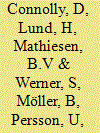|
|
|
Sort Order |
|
|
|
Items / Page
|
|
|
|
|
|
|
| Srl | Item |
| 1 |
ID:
127267


|
|
Heat roadmap Europe: combining district heating with heat savings to decarbonise the EU energy system
/ Connolly, D; Lund, H; Mathiesen, B.V; Werner, S, Möller, B, Persson, U, Boermans, T, Trier, D, Ostergaard, PA, Nielsen, S
|

|
|
|
|
| Publication |
2014.
|
| Summary/Abstract |
Six different strategies have recently been proposed for the European Union (EU) energy system in the European Commission's report, Energy Roadmap 2050. The objective for these strategies is to identify how the EU can reach its target of an 80% reduction in annual greenhouse gas emissions in 2050 compared to 1990 levels. None of these scenarios involve the large-scale implementation of district heating, but instead they focus on the electrification of the heating sector (primarily using heat pumps) and/or the large-scale implementation of electricity and heat savings. In this paper, the potential for district heating in the EU between now and 2050 is identified, based on extensive and detailed mapping of the EU heat demand and various supply options. Subsequently, a new 'district heating plus heat savings' scenario is technically and economically assessed from an energy systems perspective. The results indicate that with district heating, the EU energy system will be able to achieve the same reductions in primary energy supply and carbon dioxide emissions as the existing alternatives proposed. However, with district heating these goals can be achieved at a lower cost, with heating and cooling costs reduced by approximately 15%.
|
|
|
|
|
|
|
|
|
|
|
|
|
|
|
|
| 2 |
ID:
107499


|
|
|
|
|
| Publication |
2011.
|
| Summary/Abstract |
In this paper, three practical operation strategies (24Optimal, 24Prognostic, and 24Hsitrocial) are compared to the optimum profit feasible for a PHES facility with a 360 MW pump, 300 MW turbine, and a 2 GWh storage utilising price arbitrage on 13 electricity spot markets. The results indicate that almost all (~97%) of the profits can be obtained by a PHES facility when it is optimised using the 24Optimal strategy developed, which optimises the energy storage based on the day-ahead electricity prices. However, to maximise profits with the 24Optimal strategy, the day-ahead electricity prices must be the actual prices which the PHES facility is charged or the PHES operator must have very accurate price predictions. Otherwise, the predicted profit could be significantly reduced and even become a loss. Finally, using the 24Optimal strategy, the PHES profit can surpass the annual investment repayments required. However, over the 5-year period investigated (2005-2009) the annual profit from the PHES facility varied by more than 50% on five out of six electricity markets considered. Considering the 40-year lifetime of PHES, even with low investment costs, a low interest rate, and a suitable electricity market, PHES is a risky investment without a more predictable profit.
|
|
|
|
|
|
|
|
|
|
|
|
|
|
|
|
|
|
|
|
|